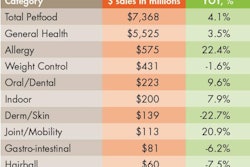By the time this article is published, pumpkin harvest for the fall season in North America will be fully underway and jack-o-lanterns/pumpkins will be decorating porches and front stoops in preparation for Halloween and other autumn harvest and Thanksgiving celebrations. Despite the seasonal and holiday affiliations they adorn, pumpkin can be found in various petfood applications year-round. Pumpkin, especially canned pumpkin, has been a staple in the raw petfood feeder’s arsenal where it is used as a fiber source to help alleviate constipation that can be an issue with this feeding plan. One will also find it as an ingredient in some specialty petfoods and in treats, but for the most part, it is nothing more than mere novelty.
Could pumpkin be more? Today, legume seeds and tubers are being used in profusion with grain-free diets, so alternative ingredients are very much in vogue. Which begs the question: might gourds, like pumpkin, be an ingredient option in petfoods, and does it make good sense for a pet’s diet?
Pumpkin is in the vine-crop Cucurbitaceae family along with squash, cucumber, cantaloupe and watermelon. It is a new world crop that pre-dates the European exploration of the Americas and was domesticated by indigenous peoples around 2,400 B.C., with buried remains of wild varietals alongside human encampments dated to 13,000 B.C. Pumpkins originated in the southern region of North America and northern regions of South America. Today, commercially grown pumpkins are either Cucurbita pepo, C. argyrosperma or C. moschata. Depending on the variety and growing practices, pumpkins can range from 1 to 1,000 lbs., but most commercial pumpkins fall within the 5–10 lbs. size with some up to 25 lbs.
Pumpkin is a very popular food item in the US and in tropical Pacific-rim countries. In 2013 there were 12.4 million cwt of pumpkins harvested from 47,800 acres in the US (NASS, 2013). The top states for production are Illinois, California, Ohio, Pennsylvania and New York. The average reported price was US$12 per cwt for a total return of US$148 million. The highest concentration of pumpkins for processing are reported to be within a 90-mile radius of Peoria, Illinois, where a large commercial cannery is located. Not coincidentally, the University of Illinois Extension Service has an entire website dedicated to pumpkins where a great deal of additional information can be found about the history and lore of this gourd.
According to the USDA Nutrient Database for Standard Reference (2014), raw pumpkin is ~92% moisture. If we expressed the other nutrients on an air-dry basis (~10% moisture) to help compare it with other dry starches, a "flour" of pumpkin would be around 10.5% crude protein, 1% fat, 8.5% ash and 70% carbohydrate (by difference). Approximately 8% of this carbohydrate comes from dietary fiber and 42% from total sugars, with the remaining 50% presumably as starch. Pumpkin is a very rich source of potassium, contains meaningful quantities of vitamin C and is also a significant source of the yellow and orange pigmented carotenoids (total carotenoids from alpha- and beta-carotene, lutein and zeaxanthan sum to nearly 1,000 mg/kg). Canned pumpkin and canned pumpkin pie filling (includes the pie spices) do not differ substantially from raw pumpkin as it regards nutrient profile.
Another commonly available component of pumpkin processing are the seeds. The whole seed is about 18% protein and 19% fat, with just under 4% ash and around 55% carbohydrate. The carbohydrate fraction is nearly 1/3 dietary fiber with the remainder likely comprised as starch. The seeds are rich in potassium and are also a rich source of linoleic acid (C18:2). The dried pumpkin seed kernels (commonly known as pepitas) differ slightly due to removal of the seed hull and are reported to be around 30% protein, nearly 50% fat and 6% total dietary fiber with a small amount of soluble sugars. Like the whole seed, the kernels are a good source of potassium, and contain appreciable quantities of phosphorus and a significant amount of linoleic acid (>20%).
While no data are available in petfood applications specifically, there are some reports where pumpkin as raw flesh, raw peel, flour and seeds have been used to produce extruded treat products, leavened breads and crackers. The closest thing to a petfood application is some interesting work by Norfezah et al. (2011) who reported the impact of various pumpkin “flour” fractions from peel, flesh and seeds added at increasing amounts (10, 30 and 50%) to extruded corn puffs. They found that as the level of each fraction increased, expansion of the puffs decreased and the product became denser and the texture became harder. This would suggest that pumpkin might not be a direct replacement for a starch like corn in an expanded petfood at amounts beyond 10%.
Further, even though the carbohydrate level is high in pumpkin, it may be more concentrated as soluble sugars and fiber rather than functional starches. This could have substantial effects on the appearance (browning of products) and utilization by the pet (stool quality). In other words, moderation may be key.
No evidence of toxicity or unintended consequences from feeding pumpkin to pets can be readily found in the literature. Generally, it is assumed to be well liked by dogs, but cats are indifferent to pumpkin as a single food item. From a labeling perspective, there isn’t a definition for pumpkin, squash or gourds in the AAFCO 2014 Official Publication so it would likely fall under the “common name” guidelines. Regardless of whether flesh or seed, a judicious use of less than 10% (on an air-dry basis) is probably best given the level of fiber and in many instances its relatively high cost compared to other staple ingredients. Today, pumpkin seed is five-fold the price of yellow peas and pumpkin (flesh) powder is more than seven-fold the price of dried potatoes.
The challenges don’t stop there—securing a consistent supply can be a big issue. Pumpkin is “campaigned” once a year in the upper Midwest; most of which is canned for the home-use market in 13–16 oz. containers. This is not exactly ideal for a commercial petfood production facility. It does appear there is interest in developing additional markets by growers—in which the petfood industry might be able to participate. However, at this stage, pumpkin use requires some planning and cooperation with the supplier.
The incorporation of pumpkin into petfood looks promising as an alternative ingredient. Perhaps not as a total replacement for functional starches, but certainly as a source of fiber and potentially other nutritional benefits. Beyond working out issues with supply and better defining its form and handling properties best suited to the petfood industry, there is an immediate need to validate the optimal use rate in dog and cat diets and to identify where issues and benefits might occur.

















